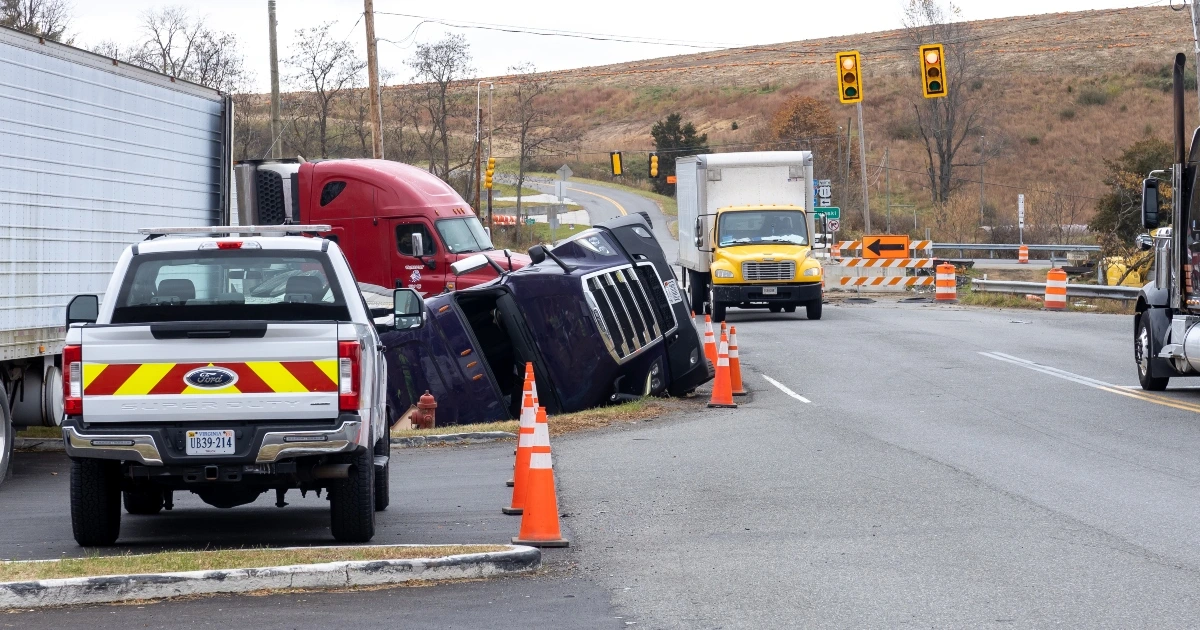Who Is at Fault When a Tire Blowout Causes a Car Accident in Cleveland?

A tire blowout on a busy road can turn an ordinary drive into a terrifying accident. Many drivers may struggle to maintain control of their vehicles in this situation. Other nearby drivers may get caught in a collision caused by the evasive actions of the driver with the bad tire.
At Friedman, Domiano & Smith, our trusted Cleveland car accident attorneys can help you understand your legal options after a car crash caused by a tire blowout. We have decades of experience helping our clients through the legal process and recognize the overwhelming burden victims may face in this situation.
Call our firm for a free consultation: 216-621-0070.
What Causes a Tire Blowout?
There are many conditions that can trigger a tire blowout on the road. Typically, long before a worn out or damaged tire becomes a problem, there are usually warning signs and multiple factors that could have been resolved early on.
What follows are some of the more common causes of tire blowouts.
Weather Conditions
Cleveland’s harsh weather conditions create numerous hazards that stress tires beyond their design limits. Summer heat causes tire pressure to increase rapidly, putting extra strain on already weakened tire walls. When temperatures soar above 90 degrees, the air inside tires expands significantly, potentially causing overinflation that can lead to sudden failure.
Winter conditions pose different but equally dangerous risks. Freezing temperatures make tire rubber brittle and more susceptible to cracking. Ice and snow force drivers to use tire chains or drive on rough, salted roads, which wear down tire treads faster than in normal conditions. Potholes filled with snow and ice become invisible hazards that can slice tire sidewalls or cause immediate blowouts upon impact.
Road Debris
Road debris poses a constant threat to tire integrity throughout the year. Construction materials, such as nails, screws, and metal fragments, that puncture tires create slow leaks, weakening the tire’s structure over time. Glass shards from broken bottles or accident debris can slice through tire walls, especially when tires are already worn or damaged.
Highway debris is another threat on the road, especially if drivers are traveling at high speeds. Truck tire retreads, commonly called “road alligators,” litter Ohio highways and can cause severe damage when vehicles strike them at over 60 mph. Cargo that falls from improperly secured loads creates unexpected obstacles that drivers cannot avoid safely.
Mechanical Failures
Tire failures that seem sudden often stem from hidden manufacturing defects. These flaws are created during production and may remain undetected until the tire is subjected to stress, typically at high speeds or during prolonged use.
- Delamination (Tire Layer Separation): Delamination occurs when adhesives between the tire layers fail, preventing the components from bonding properly. This flaw often stays hidden until heat and pressure from high-speed driving trigger a sudden blowout.
- Belt Separation: This defect occurs when the steel belts inside the tire separate from the surrounding rubber, often causing noticeable bulges or vibrations while driving. In some cases, separation occurs without warning under normal conditions, leading to potentially dangerous tire failure.
- Valve Stem Failures: Valve stems made from low-quality rubber deteriorate rapidly when exposed to chemicals and harsh weather conditions. Improper installation during mounting can create weak points. These defects often lead to rapid air loss or blowouts, especially at highway speeds.
- Sidewall Defects: Sidewall failures are particularly hazardous because they often occur without warning, resulting from manufacturing flaws and improper mounting. When tires heat up during long drives, these areas can rupture suddenly.
Age and Wear
Tire age affects safety regardless of visible tread depth or apparent condition. Rubber compounds deteriorate over time due to exposure to oxygen, heat cycles, and UV radiation from sunlight. Industry experts recommend replacing tires after six years, even if the tread appears adequate. Aging rubber loses flexibility and becomes prone to sudden failure.
Tread depth below 2/32 of an inch creates dangerous conditions where tires cannot grip wet roads effectively, leading to hydroplaning and loss of control. However, many drivers continue using tires with minimal tread because they appear functional during dry conditions. They may not realize how quickly these worn tires can fail during emergency maneuvers.
Uneven wear patterns indicate alignment problems, improper inflation, or suspension issues that cause excessive stress on certain tire areas. Drivers who ignore these warning signs often experience blowouts in the most worn sections of their tires. This typically happens during high-speed driving.
Heat buildup from under-inflation accelerates tire deterioration and increases the risk of blowouts. Tires running 20 percent below the recommended pressure generate excessive heat, which breaks down the rubber compounds and weakens the tire structure. Many drivers check tire pressure infrequently, allowing gradual air loss to create dangerous under-inflation conditions.
Who Could Be At-Fault for a Cleveland Tire Blowout?
Fault is determined based on examining the actions and responsibilities of multiple parties involved in handling, installing, manufacturing, or failing to maintain tires. Ohio law recognizes that multiple entities may be held liable for tire failures.
Driver’s Responsibilities
Vehicle owners in Ohio have a legal duty to maintain their tires in a safe operating condition and inspect them regularly for signs of wear or damage. This responsibility includes checking tire pressure monthly, rotating tires according to manufacturer recommendations, and replacing tires when tread depth falls below safe levels or when visible damage appears.
Drivers who ignore obvious warning signs of tire problems may be held partially liable for resulting accidents, especially if they were aware of the issues and failed to address them.
Common signs that require immediate attention include:
- Bulges in the tire sidewalls
- Vibrations while driving
- Uneven tread wear patterns
- Frequent air pressure loss
Manufacturer’s Liability for Defective Products
Tire manufacturers face strict liability under Ohio law when defective tires cause accidents, regardless of driver maintenance. These three main types of defects trigger manufacturer responsibility, such as:
- Manufacturing Defects: Belt separation, delamination, and sidewall failures
- Failure to Warn: Inadequate information about speed ratings, load limits, or usage risks
- Design Defects: Inherently dangerous tire designs such as belt wedge flaws, cap ply defects, and skim stock flaws
Manufacturing defects occur during production when tires fail to meet design specifications, creating hazardous conditions that may not become apparent until catastrophic failure during everyday use. Design defects can affect entire tire lines when manufacturers opt for unsafe designs, despite safer alternatives being available. Victims may have a claim against manufacturers if they are aware of certain dangers or defects in their product but fail to adequately inform consumers about those risks or limitations.
Tire recalls help to establish manufacturer liability when companies discover defects but fail to notify consumers promptly or adequately remedy the problems. Evidence of manufacturer liability requires expert analysis of failed tire components, manufacturing records, and adherence to federal safety compliance standards.
At FDS, our attorneys know how to obtain technical evidence and testimony to support these complex claims effectively, especially if your case goes to court.
Tire Shop Negligence in Installation or Repair
Repair negligence occurs when shops attempt to fix tire damage using inappropriate methods or when damage exceeds safe repair limits. Plugging punctures in tire sidewalls, repairing tires with multiple punctures, or using substandard repair materials can create dangerous conditions that lead to potential blowouts.
Tire installation and repair shops owe customers a duty to perform their services competently and safely. Negligent tire mounting, balancing, or repair work can create dangerous conditions that lead to blowouts and serious accidents.
Common tire shop negligence may include:
- Improper tire mounting can damage tire beads or create weak points during installation
- Balancing errors that cause excessive vibrations, accelerated wear, and component stress
- Valve stem installation mistakes, including over-tightening or using incorrect stem types
- Mixed tire installations with different brands, sizes, or types without customer warnings
- Failing to inspect rims for damage before mounting new tires
- Using incorrect weights during balancing that contribute to premature tire failure
What If Multiple Parties Contributed to a Cleveland Blowout Car Crash?
Ohio’s modified comparative negligence law allows you to recover compensation from multiple parties if you are less than 51 percent at fault for the accident. Courts assign a percentage of fault to each party involved, including tire manufacturers, tire shops, other drivers, and, if applicable, yourself.
For example, let’s say that the liability for your tire blowout crash was as follows:
- Manufacturer: 40 percent at fault
- Tire installer: 30 percent liable
- Another driver involved in the crash: deemed 25 percent liable
- You: Assessed with five percent liability for the crash
In this situation, you would be eligible to recover 95 percent of your medical costs and other damages from these other liable parties. Joint and several liability rules may allow you to seek compensation from all of these defendants, helping you to recover the full compensation you need for your damages.
How Do Ohio Tire Defect Laws Apply to Cleveland Accidents?
Ohio Revised Code Chapter 2307 establishes strict liability standards, making tire manufacturers automatically responsible for defective products, regardless of whether they acted negligently. Once a defect is proven, manufacturers bear full responsibility for resulting injuries irrespective of their intentions or compliance with industry standards. Ohio law prohibits manufacturers from limiting liability through warranty disclaimers, ensuring that Cleveland accident victims retain their full legal rights.
Ohio requires tire defect victims to prove four elements:
- The tire contained a defect
- The defect proximately caused their injuries.
- The defect made it unreasonably dangerous
- The defect existed when the tire left the manufacturer’s control
How Do I Know If I Have a Cleveland Injury Claim or Product Liability Case?
Victims seeking compensation in an Injury claim after a tire blowout car accident case need to prove there was negligence and that the defendant failed to exercise reasonable care and diligence. Parties who could be held liable for damages in these cases include drivers who failed to maintain their tires, tire shops that installed tires incorrectly, or entities that allowed dangerous conditions to develop by failing to properly maintain the roads.
Product liability claims target manufacturers using Ohio’s strict liability standard, requiring only proof that the tire was defective and unreasonably dangerous, not that the manufacturer acted unreasonably.
Evidence That May Help to Support Your Claim
The failed tire provides the most critical physical evidence, as expert analysis of tire fragments reveals manufacturing defects, design flaws, or maintenance issues that caused the blowout. If you can, preserve all tire pieces from the accident scene, including tread sections, sidewall fragments, and steel belting.
- Examine brake data and remaining tires to distinguish defects from poor maintenance
- Photograph the accident scene, tire debris, and vehicle damage from multiple angles with rulers for scale
- Document dashboard warning lights and maintenance records to show prior tire problem alerts
- Identify witnesses who observed the tire failure to establish mechanical failure versus driver error
- Obtain police reports and locate traffic cameras, surveillance video, or dash cam footage of the failure
- Collect emergency room records documenting immediate injuries and medical opinions linked to the crash
- Gather diagnostic imaging and follow-up treatment records to establish injury severity and ongoing impact
How Drivers Can Reduce the Risk of a Crash Due to a Tire Blowout
While driving on Cleveland’s roads, drivers are obligated to practice safe tactics to avoid an accident. They can implement these safety practices by:
- Checking tire pressure monthly when tires are cold using vehicle door placard recommendations
- Rotate tires every 5,000 to 8,000 miles to ensure even wear
- Inspect weekly for cuts, punctures, bulges, or embedded objects
- Replace tires at 2/32-inch tread depth using the penny test
- Maintain proper wheel alignment and avoid overloading your vehicle
- Replace tires after six years, regardless of tread depth, due to rubber deterioration
If your tire blows out, maintain a firm grip on the steering wheel and avoid sudden braking or jerking. Other steps you can take are:
- Gradually ease off the accelerator and steer slowly toward the wide shoulder area
- Apply brakes gently once away from traffic, turn on hazards, and call for help
- Exit the vehicle away from traffic and move to a safer location if needed
You should also be aware of steering wheel vibration, frequent air pressure loss, or sidewall cracking or bulges. If you notice these signs, it may be a sign that it is time to replace your tires.
- Uneven wear patterns or tread wear indicators appearing in grooves
- Vibrations worsening with speed require immediate professional inspection
- Sidewall damage cannot be repaired and needs immediate replacement
Call Friedman, Domiano & Smith After Suffering From Injuries in a Tire Blowout Crash
Time is critical in tire blowout cases. If you plan to seek compensation for your damages, it is important that you seek legal help as soon after your crash as possible.
If you were injured in a Cleveland tire blowout accident caused by the negligence of others, we are prepared to help you fight for fair compensation.
At Friedman, Domiano & Smith, we have a highly qualified legal team with a strong history of proven results. We advocate for injured victims every day, something we have been doing for decades.
Need legal help after a car crash? We are ready to work tirelessly on your behalf. There are no upfront costs to pay, as we take all injury cases on contingency. Call to request your FREE case review today.
Call our firm today to learn more about your legal options: 216-621-0070.
Comments are now closed




Comments